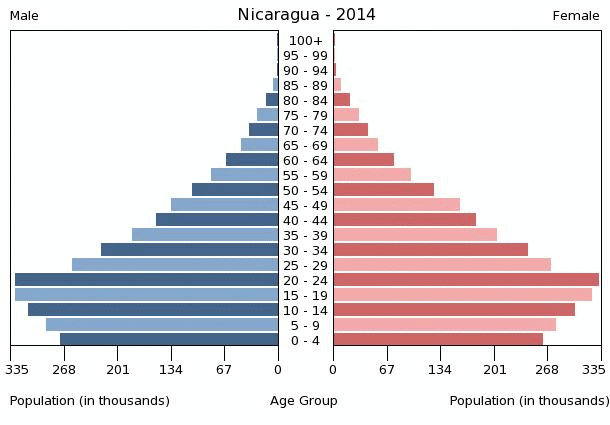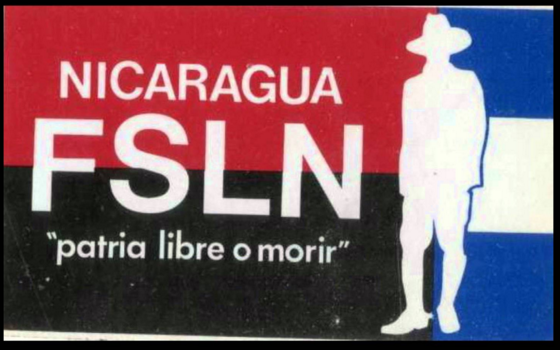Higher Education in Nicaragua
Background
Nicaragua is the second poorest country in Latin America, behind only Haiti. Nicaragua also has the “youngest” population in Central America, with about 50% its of people under the age of eighteen and about 40% of the population under the age of fourte en. Because there are so many young people in the country, there is more demand than ever for a quality education system that empowers the youngest generation to enroll in college-level programs that prepare them to be the future leaders of their developing nation. Unfortunately, although the education system in Nicaragua has advanced over the years following the revolution, there is still an incredibly small percentage of students that are enrolling in college. Around 14% of the population enrolls in college, and of those students who enroll in a university, only about 37% graduate with a degree. (Bernheim 2008)
en. Because there are so many young people in the country, there is more demand than ever for a quality education system that empowers the youngest generation to enroll in college-level programs that prepare them to be the future leaders of their developing nation. Unfortunately, although the education system in Nicaragua has advanced over the years following the revolution, there is still an incredibly small percentage of students that are enrolling in college. Around 14% of the population enrolls in college, and of those students who enroll in a university, only about 37% graduate with a degree. (Bernheim 2008)
History
The first institution of higher in education in Nicaragua, the National Autonomous University of Nicaragua at León (UNAN-León), was founded in 1812 by the Spanish during the colon ial period. Originally called the University of León, the university did not become a national university until 1947 when the Nicaraguan Ministry of Education took control of the appointment of its teachers and officers. When it became a state university in 1951, the university gained autonomy over its academic, economic, and administrative matters. This issue of autonomy and constant changes in the government’s role in the governance of institutions of higher learning persisted until very recently (1990). Soon after, in 1960, the country’s first private university, the Central American University (UCA) was founded. (Bernheim 2008)
ial period. Originally called the University of León, the university did not become a national university until 1947 when the Nicaraguan Ministry of Education took control of the appointment of its teachers and officers. When it became a state university in 1951, the university gained autonomy over its academic, economic, and administrative matters. This issue of autonomy and constant changes in the government’s role in the governance of institutions of higher learning persisted until very recently (1990). Soon after, in 1960, the country’s first private university, the Central American University (UCA) was founded. (Bernheim 2008)
Sandinista Impact on Higher Education
In 1980, the year following the Sandinista triumph in the Nicaraguan revolution, any autonomy granted to universities in Nicaragua was basically taken away by the National Council of Higher Education (CNES), in an effort to align the goals of higher education in Nicaragua with the governmental goals of the Sandinista regime. About ten years later, in 1990, the national assembly passed “Ley 89” (Law 89), which granted complete autonomy to all Nicaraguan universities in all aspects of their governance, including academic, financial, and administrative aspects. An excerpt from the exact text of this law is shown below. In this same year, the National Council of Universities (CNU) was formed as an advisory board for public universities and some private universities.
Article 125 – Ley 89 – April 5th 1990: “Universities and Higher Technical Education Centers enjoy academic, financial, organizational and administrative autonomy, in accordance with the law. They shall be exempt from all taxation and tax contributions, regional and municipal. Their assets and income shall not be subject to intervention, expropriation or seizure, unless the obligation is asserted, has its origin in civil contracts, commercial or labour. Teachers, students and administrative workers are involved in university management. Universities and Higher Technical Education Centres which by law must be funded by the state, will receive an annual contribution of 6% of the general budget of the Republic, which will be distributed in accordance with the law. The State may grant additional contributions for extraordinary expenses of such universities and centres of higher technical education. It guarantees academic freedom. The State promotes and protects the free creation, research and dissemination of science, technology, arts and letters, and ensures and protects intellectual property. ” (Universidad Azteca)
The Sandinistas also worked to improve access to education overall as a part of their general mission once they came into power. They doubled federal spending on education and increased the number of teachers and the number of schools in the country. In 1980, the Ministry of Education launched what were kno wn as “Popular Education Cooperatives,” which were programs that provided educational materials to adults who were able to meet up on their own time outside of work, usually in the evenings, and teach themselves mathematics and reading. This tied in with the Sandinista campaign to combat illiteracy, and in the years following the campaign, the percentage of the population that was illiterate dropped from 50% to 23%. (Bernheim 2008)
wn as “Popular Education Cooperatives,” which were programs that provided educational materials to adults who were able to meet up on their own time outside of work, usually in the evenings, and teach themselves mathematics and reading. This tied in with the Sandinista campaign to combat illiteracy, and in the years following the campaign, the percentage of the population that was illiterate dropped from 50% to 23%. (Bernheim 2008)
Types of Universities
After 1990, the number of private universities in the country increased dramatically. As of 2006, there were 53 universities in Nicaragua, a number that has probably increased slightly since. They can be divided into five basic categories based on where they get their funding from and their relationship with the National Council of Universities (CNU). Public universities get their funding from the government, and all four of Nicaragua’s public universities are members of the CNU. Private universities are privately funded, but the five private universities that are members of the CNU receive a portion of their funding from the government. There are 42 other private universities in Nicaragua that are not part of the CNU, but are still recognized by the CNU. These institutions are entirely funded through private sources, and therefore charge the highest rates for tuition. The two other categories each contain one university: private universities that are not recognized by the CNU at all and technical centers of higher education that are part of the CNU. This breakdown of the Nicaraguan universities can be seen in the table below. (Bernheim 2008)
 Programs and Degrees
Programs and Degrees
Three main stages of study make up the Nicaraguan higher education system. The first stage, or Licenciatura (Licentiate) is the most basic degree that you can earn. Depending on your major, it can take from 4-6 years to earn Licenciatura. A Licenciatura provides qualification for professional work in Medicine (6 years), Engineering (5 years), and Architecture (5 years). After earning a Licenciatura, students may choose to go on to pursue the second stage of study: Masrería (Master’s) or Especialización (Specialization). This second stage of study is typically 1-2 years of additional study after the receipt of a Licenciatura, and in order to complete it, the student must present a thesis. People commonly pursue a Mastería or Especialización in subjects like Law, Psychology,  Medicine, Health Sciences, Economics, Education, and Social Sciences. The third and final stage of higher education is that of the Doctorado (Doctorate) which entails an additional 2-3 years of study after the receipt of a Mastería or Especialización in a given field. Just as with the former stage of study, in order to receive a Doctorado, students must present a thesis. Common subjects that students choose to pursue a Doctorado in are Health Sciences, Psychology, Law, Education, and Business Administration. (Universidad Azteca)
Medicine, Health Sciences, Economics, Education, and Social Sciences. The third and final stage of higher education is that of the Doctorado (Doctorate) which entails an additional 2-3 years of study after the receipt of a Mastería or Especialización in a given field. Just as with the former stage of study, in order to receive a Doctorado, students must present a thesis. Common subjects that students choose to pursue a Doctorado in are Health Sciences, Psychology, Law, Education, and Business Administration. (Universidad Azteca)
Financial Information
Paying for college is often a large source of stress for families in the United States, and this is no different for Nicaraguan families. The average cost of college in Nicaragua pales in comparison to the average cost of college in the United States, but financial matters are certainly still a huge barrier that inhibits access to higher education for students in Nicaragua. On average attending a Nicaraguan university costs anywhere between $30 to $120 (800 to 3,000 Nicaraguan córdoba) per month. (Bernheim 2008) State universities (members of the CNU) grant financial aid to about 75% of attendees (Bernheim 2008), but the low retention and graduation rates in Nicaraguan colleges can probably be attributed to an extra fee of about $1,000 (28,000 córdoba), called the “seminario de titulación) that students must pay right before graduating in order to receive their diploma. (Vittana.org)


I have an applicant who claims to have a degree from the Universidad Nacional de Nicaragua – Managua in Economics from 1978. He does not have proof of matriculation on hand. Obviously this was a difficult time and he left the country shortly after for the US. What is the state of educational records from that period and what would be the best way for him to get a verification of degree?